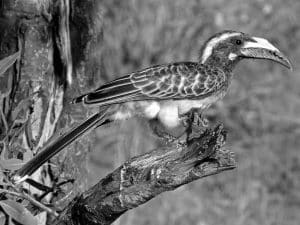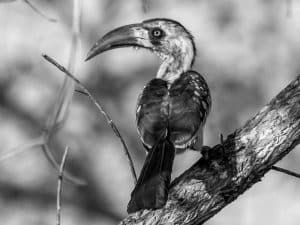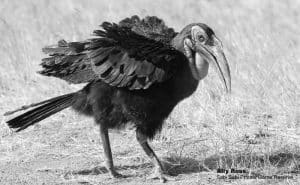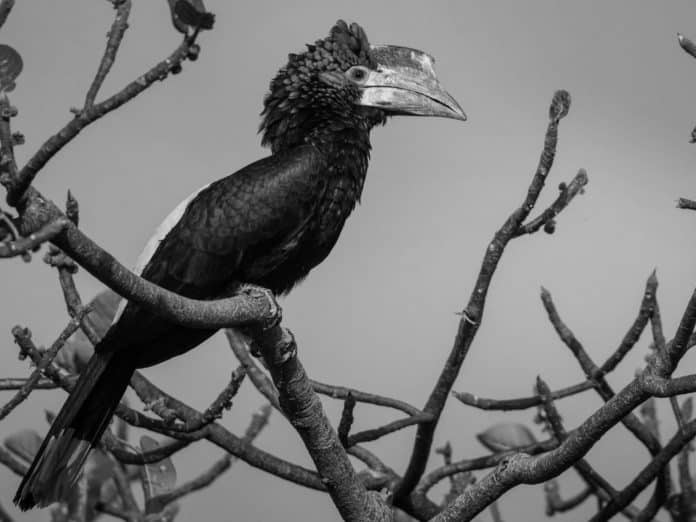Introduction to Hornbills in Tanzania
Tanzania, with its diverse landscapes ranging from savannas to mountains, provides an ideal habitat for a variety of wildlife, including a remarkable array of hornbill species. These distinctive birds are known for their long, down-curved bills and often colorful casques, which are prominent features that set them apart in the avian world. With their unique appearance and fascinating behaviors, hornbills have captured the attention of bird enthusiasts and researchers alike, making Tanzania a prime destination for those seeking to observe these remarkable creatures in their natural environment.

The hornbills in Tanzania play a crucial ecological role, contributing to seed dispersal, insect control, and maintaining the balance of the ecosystem. Their significance in the natural world makes them an integral part of Tanzania’s wildlife and underscores the importance of understanding and conserving these magnificent birds.
Different Species of Hornbills Found in Tanzania
Tanzania is home to a diverse range of hornbill species, each exhibiting its own unique characteristics and behaviors. Among the notable species found in Tanzania are the Southern Ground Hornbill, the Von der Decken’s Hornbill, the Crowned Hornbill, the Trumpeter Hornbill, and the Silvery-cheeked Hornbill, to name a few. These species vary in size, coloration, and habitat preferences, contributing to the rich tapestry of hornbill diversity in Tanzania.
The Southern Ground Hornbill, with its striking red facial skin and impressive size, is one of the iconic hornbill species found in Tanzania. Known for its ground-dwelling habits and distinct booming calls, this species holds a special place in the hearts of bird enthusiasts and conservationists alike. The Von der Decken’s Hornbill, on the other hand, is recognized by its vibrant yellow and black casque, while the Crowned Hornbill displays a distinctive black and white plumage with a striking casque of its own. These varied species collectively contribute to the captivating allure of hornbill watching in Tanzania, offering an enriching experience for nature enthusiasts.
Habitat and Distribution of Hornbills in Tanzania
The diverse habitats of Tanzania provide an ideal environment for a wide range of hornbill species to thrive. From the open woodlands of the Serengeti to the lush forests of the Eastern Arc Mountains, hornbills can be found across a spectrum of landscapes, each with its own distinct ecological characteristics. The distribution of hornbills in Tanzania reflects their adaptability to different environments, showcasing their ability to inhabit savannas, woodlands, and montane forests with equal ease.
The Southern Ground Hornbill, for instance, is often found in open savannas and grasslands, where it forages for a variety of prey, including insects, small mammals, and reptiles. In contrast, the Silvery-cheeked Hornbill prefers the dense canopy of montane forests, where it feeds on fruits and plays a vital role in seed dispersal. Understanding the diverse habitats and distribution patterns of hornbills in Tanzania is essential for conservation efforts and for ensuring the long-term survival of these remarkable birds.
Importance of Hornbills in Tanzanian Ecosystem
Hornbills play a significant role in maintaining the balance of the Tanzanian ecosystem, contributing to seed dispersal, insect control, and the regeneration of forests. As frugivorous birds, many hornbill species consume a variety of fruits and play a crucial role in dispersing seeds across different habitats. This process of seed dispersal not only aids in the regeneration of plant species but also contributes to the overall health and diversity of the ecosystem.
In addition to their role in seed dispersal, hornbills are effective predators of insects, particularly in agricultural areas where they help control pest populations. By preying on insects that can cause damage to crops, hornbills provide a natural form of pest control, offering ecological benefits that directly impact human livelihoods. Recognizing the importance of hornbills in maintaining the ecological balance highlights the need for conservation efforts to safeguard their habitats and ensure their continued presence in the Tanzanian landscape.
Conservation Efforts for Hornbills in Tanzania

Conservation initiatives aimed at protecting hornbills in Tanzania are crucial for preserving the rich diversity of these birds and maintaining the integrity of their habitats. Organizations and local communities are actively involved in conservation efforts, focusing on habitat protection, research, and community engagement to address the various threats faced by hornbills in the region.
Habitat loss and fragmentation due to deforestation and agricultural expansion pose significant challenges to hornbill populations in Tanzania. By establishing protected areas and promoting sustainable land use practices, conservationists strive to create safe havens for hornbills and other wildlife. Moreover, research efforts aimed at understanding hornbill behavior, population dynamics, and ecological interactions provide valuable insights for conservation strategies and the effective management of hornbill populations.
Community involvement is also integral to hornbill conservation, as local communities play a vital role in safeguarding the habitats and resources upon which hornbills depend. Through education and outreach programs, conservation organizations work with communities to foster a deeper understanding of the value of hornbills and the importance of preserving their natural environment. These collaborative efforts are essential for the long-term conservation of hornbills in Tanzania and contribute to the broader goal of protecting the country’s biodiversity.
Best Places for Bird Watching and Hornbill Spotting in Tanzania
Tanzania offers a myriad of opportunities for bird enthusiasts to observe hornbills in their natural habitat, with several key locations renowned for their rich birdlife and diverse hornbill species. The national parks and conservation areas of Tanzania provide a haven for bird watching, offering a chance to witness an array of hornbill species amidst stunning landscapes and unique ecosystems.
The Serengeti National Park, famous for its iconic savannas and diverse wildlife, is a prime destination for bird enthusiasts seeking to encounter the Southern Ground Hornbill and other hornbill species that inhabit the grasslands. The lush forests of the Udzungwa Mountains National Park are home to the endemic Iringa Red Colobus monkey and provide an excellent opportunity to observe the endemic and colorful species of hornbills found in the area.
The Selous Game Reserve, with its expansive wilderness and abundant birdlife, offers a remarkable bird watching experience, allowing visitors to encounter the Von der Decken’s Hornbill and other avian treasures. Additionally, the Tarangire National Park, known for its ancient baobab trees and diverse bird species, provides an ideal setting for spotting the striking Crowned Hornbill and the elusive Trumpeter Hornbill.
Unique Behaviors and Characteristics of Tanzanian Hornbills
The hornbills of Tanzania exhibit a fascinating array of behaviors and characteristics that contribute to their allure and captivate the imagination of bird enthusiasts. From their distinctive calls and courtship displays to their nesting habits and foraging techniques, hornbills present a captivating spectacle of natural history, offering a window into the intricacies of avian life in Tanzania.
One of the remarkable behaviors displayed by hornbills is their nesting habits, characterized by their use of natural tree cavities or self-excavated holes for shelter and rearing their young. This nesting behavior, often accompanied by elaborate courtship rituals and vocalizations, underscores the complexity of hornbill social dynamics and their role in the perpetuation of their species. The unique nesting requirements of hornbills make them reliant on specific habitat features, emphasizing the importance of preserving their natural environments for their continued survival.
Hornbills are also known for their distinctive calls, which vary among species and serve as a means of communication, territorial defense, and mate attraction. The resonant calls of hornbills reverberate through the forests and savannas of Tanzania, adding to the symphony of sounds that define the natural world. Observing these vocalizations and understanding their significance provides valuable insights into the behavior and ecology of hornbills, enriching the experience of bird enthusiasts and researchers alike.
Challenges Faced by Hornbills in Tanzania

Despite their ecological importance and cultural significance, hornbills in Tanzania face a myriad of challenges that threaten their populations and habitats. Habitat loss and degradation due to deforestation, agricultural expansion, and human development pose a significant threat to the survival of hornbills, leading to the fragmentation of their habitats and restricting their access to essential resources.
Furthermore, the illegal wildlife trade poses a grave threat to hornbill populations, as these birds are often targeted for their casques and body parts, which are used in traditional medicine and cultural practices. The exploitation of hornbills for such purposes not only endangers their populations but also disrupts the delicate balance of the ecosystem, affecting the broader biodiversity of Tanzania.
Climate change also presents a growing concern for hornbills, as altering weather patterns and environmental conditions can impact their foraging behavior, breeding success, and overall survival. Adapting to these changing conditions requires a concerted effort to mitigate the effects of climate change and implement strategies that safeguard the habitats and resources vital to the well-being of hornbill populations.
The Role of Ecotourism in Hornbill Conservation
Ecotourism plays a pivotal role in hornbill conservation by promoting sustainable practices, raising awareness, and generating support for the protection of natural habitats and wildlife. Responsible ecotourism initiatives in Tanzania provide an avenue for visitors to engage with the country’s rich biodiversity, including its diverse hornbill species, while contributing to conservation efforts and community development.
By participating in guided bird watching tours and nature-based experiences, visitors have the opportunity to appreciate the beauty and significance of hornbills in their natural environment, fostering a deeper understanding of the need to protect these magnificent birds. Additionally, the revenue generated from ecotourism activities can be channeled into conservation programs, habitat restoration, and community projects, creating a positive impact on the preservation of hornbill habitats and the well-being of local communities.
Furthermore, ecotourism initiatives that prioritize ethical and sustainable practices can serve as a powerful tool for advocating the protection of hornbills and raising awareness about the threats they face. Through education and engagement, ecotourism contributes to the conservation of hornbills in Tanzania, creating a harmonious balance between the preservation of natural resources and the enjoyment of sustainable tourism experiences.
Conclusion
In conclusion, the rich diversity of hornbills in Tanzania offers a captivating glimpse into the intricate tapestry of the country’s natural heritage. From the vibrant landscapes of the Serengeti to the ancient forests of the Udzungwa Mountains, Tanzania provides a haven for a remarkable array of hornbill species, each contributing to the ecological richness and cultural significance of the region. Understanding the importance of hornbills in the Tanzanian ecosystem, the challenges they face, and the role of conservation and ecotourism is essential for safeguarding their future and preserving the natural wonders of Tanzania.


































